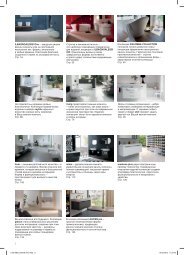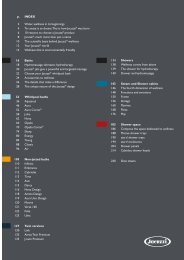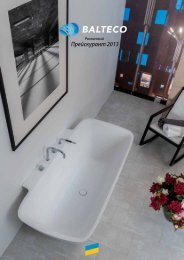You also want an ePaper? Increase the reach of your titles
YUMPU automatically turns print PDFs into web optimized ePapers that Google loves.
254<br />
Slim. Technical informations.<br />
Slim is porcelain stoneware produced by <strong>Marca</strong> <strong>Corona</strong>. It has 4.8mm thickness and it is manufactured in compliance with EN ISO 14411-G standards for technical performance.<br />
Cutting and manufacturing process<br />
Slim can be cut and shaped with the same machinery used in the manufacturing of porcelain stoneware (horizontal cutter and diamond blades). If worked upon on a flat and<br />
clean work-top, it can also be cut using glass cutters. If intending to cut using diamond blades, the use of “smooth crown blades” is required, which can be used either manually<br />
(via a grinder) or via dedicated cutting-tops. It is recommended to pay particular attention to the rotation speed, which must be always greater than 2500 rpm while the cutting<br />
speed must not fall below 1mt/min. As it is full-body coloured porcelain stoneware, the cutting disks used in the manufacturing of this product are the same as the ones used<br />
during porcelain stoneware production process.<br />
drilling<br />
All manual drilling must be be carried out using tungsten bits or bits specifically designed for the drilling of glass with a maximum diameter of 8mm. <strong>Marca</strong> <strong>Corona</strong> recommends<br />
paying particular attention to the following processes:<br />
1. Cool the point being drilled with water;<br />
2. Commence drilling with a low rotation speed;<br />
3. Do not exert excess pressure during drilling;<br />
4. Avoid drilling in proximity of edges;<br />
5. For drilling process carried out during installation, wait for the grout to dry.<br />
For all drilling operations requiring more than 8mm diameter, the use of cutting discs mounted on a drill or on angle-grinders is recommended. For high-precision profiling cuts,<br />
hydro-jet cut is recommended.<br />
Warning: never use hammering tools for drilling.<br />
installation on walls<br />
Slim can be pasted onto indoor and outdoor walls, in particular on surfaces not suited to carrying a lot of weight stress. It can be installed onto the following support materials:<br />
concrete pre-existing ceramic marble expanded cement masonry<br />
metal cement-based plasters plasterboard agglomerated wood panels<br />
installation onto pre-existing wall covering<br />
PREPARATION Prior to proceeding with installation, it is recommended to check that the pre-existing wall covering is duly anchored and dry. Any detached or cracked tiles must<br />
be removed before the installation of the new product. The gaps which will be created following the removal of damaged pre-existing tiles must be filled with suitable cementbased<br />
products. In case of ex-novo wall installation, it is necessary to check that the substrate is dry, that it has no cracks and that its hygrometric shrinkage is completed. Before<br />
installation, the surface must be duly cleaned removing any dust, dirt or oil and waxy residue. It is also necessary to check the planarity of the surface and fill uneven areas with<br />
suitable levelling products.<br />
APPLICATION OF ThE ADhESIVE The adhesive must be applied full-bed on the substrate using a tilted teeth trowel or a trowel with 4-6mm flat teeth, so that the adhesive<br />
applied on the substrate covers 100% of Slim slab. In order to ensure perfect adhesion of the product and avoid the forming of air bubbles, it is necessary to exert pressure onto<br />
the slab using a rubber trowel and then proceeding with an homogeneous tapping of the surface. <strong>Marca</strong> <strong>Corona</strong> recommends allowing a 2mm grout line in order to guarantee<br />
the best aesthetic and technical performances of the surface. <strong>Marca</strong> <strong>Corona</strong> also recommends paying particular attention to the spreading of the adhesive and avoid overflowing<br />
as well as the use of suitable spacer crosses.<br />
The placing, type and number of expansion joints must be calculated by the foreman responsible for the building site.<br />
SUGGESTIONS Slim can be matched with standard thickness floors of the same collection, in fact Slim has the same aesthetic features, the same work-size and the same<br />
modularity.<br />
installation on floors<br />
Slim is perfect for wall coverings but is also suitable for the renovation of pre-existing floors. It can be installed on marble, natural stone, ceramic or terracotta floors avoiding<br />
demolition and reducing the costs usually associated with renovation projects. <strong>Marca</strong> <strong>Corona</strong> recommends the use of Slim exclusively in residential and light commercial venues<br />
and in areas that are not subject to heavy weight stress and in areas where there is no circulation of hard-tyre trolleys. Its use on floors is restricted to indoor areas or perfectly<br />
water-proof porches.<br />
PREPARATION Prior to proceeding with the installation of Slim on the pre-existing stone floor, it is necessary to check the anchorage of such pre-existing covering to the<br />
substrate. The substrate must be dry, stable, solid, perfectly planar and free from detached and/or removable elements which could compromise the adhesion of the product.<br />
Any detached or cracked tiles must be removed before the installation of the new product. The gaps which will be created following the removal of damaged pre-existing tiles<br />
must be filled with suitable cement-based products. The control of the planarity of the surface must be carried out using a straight edge (of at least 2 meters in length) and any<br />
unevenness must be filled with suitable levelling products. In case of ceramic, marble, stone and terracotta floors, it is recommended to pre-clean the surface using a solution<br />
made of caustic soda diluted in water and rinse frequently in clean water; if the above cleaning procedure cannot be carried out, mechanical abrasion is recommended.<br />
APPLICATION OF ThE ADhESIVE The adhesive must be applied using the double spreading technique in order to ensure a suitable adhesion, thus avoiding the formation of<br />
gaps. The adhesive must be spread full-bed onto the pre-existing covering using a trowel with tilted teeth set a distance of 6mm apart. The adhesive must be applied full-bed<br />
on the substrate using a tilted teeth trowel or a trowel with 4-6mm flat teeth, when using full-bed and/or self-wetting adhesives, use a round teeth trowel as recommended by<br />
manufacturers. The application of the adhesive on the back of the slab must be carried out using a flat trowel. In order to ensure perfect adhesion of the product and avoid the<br />
creation of air bubbles, it is necessary to exert pressure on the slab using a rubber brush and then proceeding with an homogeneous tapping of the surface.<br />
Before the adhesive dries completely, make sure that grout lines have no residue of adhesive, and if there is any, remove any residue before grouting (both in case of cement<br />
and epoxy grouting). In order to guarantee the best aesthetic and functional performance of the product, <strong>Marca</strong> <strong>Corona</strong> recommends allowing a 2mm grout line and the use<br />
of suitable spacer crosses. Place the expansion joints at regular intervals and leave a space of at least 5mm between the tiled floor and the wall. Once the floor is completed,<br />
additional skirting will cover this 5mm space giving a uniform look.<br />
The placing of expansion joints must be calculated by the foreman responsible for the building site. Do not tread on the floor during and for at least 24 hours after installation.<br />
SUGGESTIONS We recommend paying particular attention to adhesive drying times indicated by manufacturers. <strong>Marca</strong> <strong>Corona</strong> strongly recommend avoiding installation of Slim<br />
directly onto the footing, this is because installation on footing mainly depends on the correct installation of the footing itself, on its complete seasoning, on the compliance of its<br />
expansion joints and on the state of the art installation performance. Therefore, in such cases, <strong>Marca</strong> <strong>Corona</strong> suggests the use of standard thickness porcelain stoneware.<br />
Handling<br />
Thanks to their lightness, Slim slabs can easily be moved by hand. Once taken out of the packaging, care must be taken with their positioning, placing the longer side on the<br />
ground at a 30° degree angle to the wall. <strong>Marca</strong> <strong>Corona</strong> recommends taking extra care with the edges of the slabs.<br />
installation<br />
<strong>Marca</strong> <strong>Corona</strong> recommends carefully checking shade, work-size and grade of tiles before installation, as no claims relating to such defects will be accepted once the ceramic<br />
material has been installed.<br />
During installation, we suggest alternating tiles from different boxes.<br />
We recommend glue installation as it is more resistant, particularly for large size tiles. We remind you, that, when proceeding with installation, the substrate must be stable, dry,

















